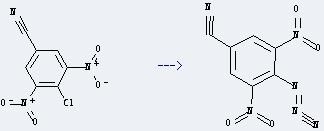-
Name
4-CHLORO-3,5-DINITROBENZONITRILE
- EINECS 21-766-4
- CAS No. 1930-72-9
- Article Data5
- CAS DataBase
- Density 1.68 g/cm3
- Solubility Insoluble in water.
- Melting Point 140.5-141 °C
- Formula C7H2ClN3O4
- Boiling Point 326.3 °C at 760mmHg
- Molecular Weight 227.564
- Flash Point 151.2 °C
- Transport Information
- Appearance YELLOW CRYSTALLINE POWDER
- Safety 26-37/39
- Risk Codes 20/21/22-36/37/38
-
Molecular Structure
-
Hazard Symbols
 Xn
Xn
- Synonyms 3,5-Dinitro-4-chlorobenzonitrile;4-Chloro-3,5-dinitrobenzonitrile;NSC 74453;
- PSA 115.43000
- LogP 3.07448
Benzonitrile,4-chloro-3,5-dinitro- Specification
The Benzonitrile,4-chloro-3,5-dinitro- is an organic compound with the molecular formula C7H2ClN3O4. Its CAS registry number is 1930-72-9. The IUPAC name of this chemical is called 4-Chloro-3,5-dinitrobenzonitrile. It belongs to the product categories of Aromatic Nitriles; C6 to C7; Cyanides/Nitriles; Nitrogen Compounds. Its EINECS number is 21-766-4. What’s more, the molecular weight of this chemical is 227.56. Its classification code is Drug / Therapeutic Agent.
Physical properties about Benzonitrile,4-chloro-3,5-dinitro- are: (1)ACD/LogP: 0.75; (2)#of Rule of 5 Violations: 0; (3)ACD/LogD (pH 5.5): 0.75; (4)ACD/LogD (pH 7.4): 0.75; (5)ACD/BCF (pH 5.5): 2.18; (6)ACD/BCF (pH 7.4): 2.18; (7)ACD/KOC (pH 5.5): 60.8; (8)ACD/KOC (pH 7.4): 60.8; (9)#H bond acceptors: 7; (10)#H bond donors: 0; (11)#Freely Rotating Bonds: 2; (12)Polar Surface Area: 115.43Å2; (13)Index of Refraction: 1.631; (14)Molar Refractivity: 48.21 cm3; (15)Molar Volume: 135.2 cm3; (16)Polarizability: 19.11×10-24 cm3; (17)Surface Tension: 79.8 dyne/cm; (18)Density: 1.68 g/cm3; (19)Flash Point: 151.2 °C; (20)Enthalpy of Vaporization: 56.85 kJ/mol; (21)Boiling Point: 326.3 °C at 760 mmHg; (22)Vapour Pressure: 0.000217 mmHg at 25 °C.
Uses of Benzonitrile,4-chloro-3,5-dinitro-: it can be used to produce other chemicals. For example, it is used to produce 4-azido-3,5-dinitro-benzonitrile. The reaction occurs with reagent NaN3 and solvent 1,2-dichloro-ethane at 50 ℃ for 4 hours. The catalyzator is benzyltributylammonium bromide. The yield is 94 %. The reaction equation is as followed:

When you are dealing with this chemical, you should be very careful. This chemical is harmful by inhalation, in contact with skin and if swallowed and may cause damage to health. It is irritating to eyes, respiratory system and skin. What's more, in case of contact with eyes, you should rinse immediately with plenty of water and seek medical advice. You also should wear suitable gloves and eye/face protection. In addition, it should be stored in a cool, dry and sealing place.
You can still convert the following datas into molecular structure:
(1) SMILES: O=[N+]([O-])c1cc(C#N)cc([N+]([O-])=O)c1Cl
(2) InChI: InChI=1/C7H2ClN3O4/c8-7-5(10(12)13)1-4(3-9)2-6(7)11(14)15/h1-2H
(3) InChIKey: SCGDEDHSPCXGEC-UHFFFAOYAA
The toxicity data is as follows:
| Organism | Test Type | Route | Reported Dose (Normalized Dose) | Effect | Source |
|---|---|---|---|---|---|
| mouse | LD50 | intraperitoneal | 50mg/kg (50mg/kg) | Farmaco, Edizione Scientifica. Vol. 41, Pg. 41, 1986. |
Related Products
- Benzonitrile
- Benzonitrile, 2,4-dichloro-6-methyl-
- Benzonitrile, 2,4-dimethoxy-6-methyl-
- Benzonitrile, 2,6-dinitro-
- Benzonitrile, 2-[(6-chloro-3,4-dihydro-2,4-dioxo-1(2H)-pyrimidinyl)methyl]-
- Benzonitrile, 2-amino-4-nitro-
- Benzonitrile, 2-chloro-3-formyl-
- Benzonitrile, 2-chloro-4-fluoro-3-methyl-
- Benzonitrile, 2-chloro-6-methoxy-
- Benzonitrile, 2-ethyl-
- 1930-84-3
- 193085-24-4
- 193090-60-7
- 193091-13-3
- 19309-14-9
- 193098-40-7
- 19309-90-1
- 19311-37-6
- 19311-38-7
- 19311-79-6
Hot Products
About|Contact|Cas|Product Name|Molecular|Country|Encyclopedia
Message|New Cas|MSDS|Service|Advertisement|CAS DataBase|Article Data|Manufacturers | Chemical Catalog
©2008 LookChem.com,License: ICP
NO.:Zhejiang16009103
complaints:service@lookchem.com Desktop View